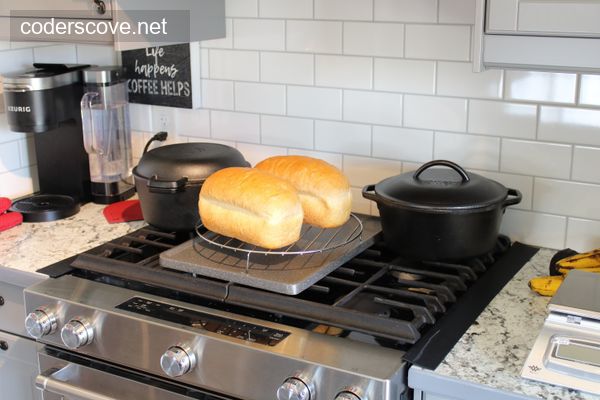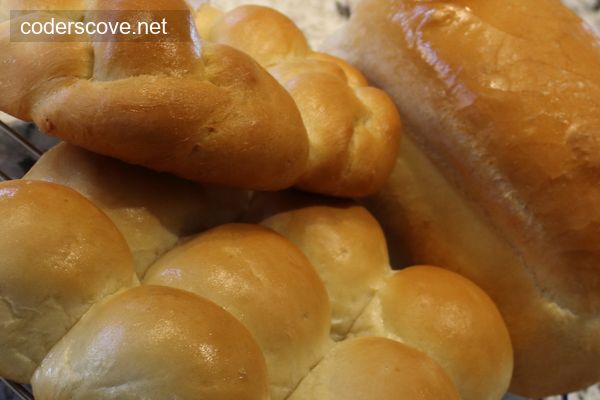

Active Dry Yeast Bread
If you are new to baking bread and want to 'Master The Dough', this recipe is an excellent place to start. It is relatively simple and following the directions closely produces consistent results.
Ingredients
| Description | Grams | % |
| Strong Bakers Flour (13⅓ % protein) |
800 | 100 |
| Warm Water @ 40-45°C | 540 | 67.5 |
| White Granulated Sugar | 24 | 3 |
| Active Dry Yeast | 8 | 1 |
| Fine Sea Salt | 16 | 2 |
| Olive Oil | 24 | 3 |
| Olive oil to grease bowl | 8 | 1 |
Instructions
- Heat 540 grams of bottled or filtered water to 40-45°C.
- Turn your oven on to 'Proof' mode (26°C).
- In a small bowl, stir the white sugar and yeast into 120 grams (½ cup) of the heated water until completly dissolved. Let sit for 5 minutes.
- In a large bowl, stir the salt into the remaining 420 grams of heated water until completly dissolved. Stir in the oil. Stir in the sugar and yeast mixture.
- Add the 800 grams of flour, one scoop at a time. Mix each scoup thoroughly with a dough whisk, or a wooden spoon. The mixture should have a rough shaggy, sticky consistency. Cover the bowl with a clean, damp tea towel and let rest for 10 minutes.
- Using a bowl scraper, place the mixture onto a kneading surface. Use the slap and fold technique to knead the dough. Using a bench scraper or knife, walk the dough into a uniform ball shape.
- Thoroughly grease the large bowl with 8 grams of olive oil. Roll the dough ball in the greased bowl to cover it with the oil. Cover the bowl with a clean, damp tea towel and place in your oven set to 'Proof', or a warm location (ideally 26°C).
- Let rise for 1 hour or until the dough ball doubles in size.
- Using a bowl scraper, return the dough to a kneading surface. Gently knead out major CO2 bubbles.
- Using a bench knife and a scale, divide the dough into two equal pieces, aproximately 706 grams each.
- Use the lamination technique to shape each piece into a rolled loaf. Place into the loaf pans.
- Place loaf pans into your oven set to 'Proof', or a warm location (ideally 26°C). Cover with a clean, damp tea towel.
- Let the loafs rise for 1 hour or until they have doubled in size.
- Bake at 375 degrees farenheight for 45 to 55 minutes or until the crust is a light golden color.
- Remove from the oven to a cooling rack. After 5-10 minutes, remove from pans. For a softer crust, brush with a very small amount of melted butter.
- Let cool for two hours before slicing.
Notes
Don't be afraid to experiment with different types of flour. There is a huge variety of flours available, many of which are organic. Substituting in some whole-grain flour can significantly change the flavor, texture, and nutritional value.
Whole-grain flours are “thirstier,” therefore doughs made with whole-grain flours typically require a little more water. The type of flour can also affect the rising time, volume, and crumb density.
I tend to use 600 grams of strong bakers flour and experiment with 200 grams (25%) of whole wheat, dark rye, red fife, einkorn, spelt or a combination thereof. When adding whole wheat flour, I also increase the water to 70% hydration (560 grams).